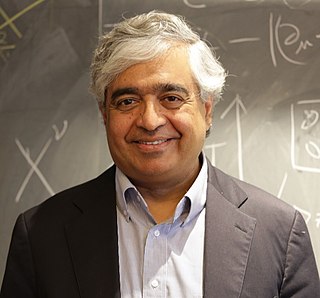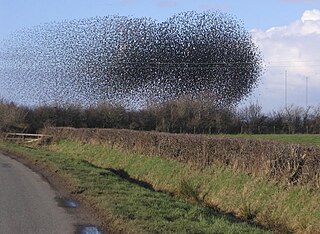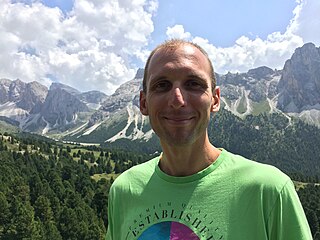Research activities
Dirk Helbing started out as a physicist. His diploma thesis focussed on pedestrian, crowd, and evacuation modeling and simulation. [21] During his PhD and habilitation in physics, [22] he helped to establish the fields of socio-, econo- and traffic physics. [23] [24] He was also co-founder of the Physics of Socio-Economic Systems Division of the German Physical Society (DPG). [25] As a visiting scientist at Tel Aviv University and the Weizmann Institute in Israel, the Eötvös University in Budapest, and Xerox PARC in California, he focused on a broad variety of complex systems - including the self-organisation of pedestrians, [26] traffic jams, [27] bacterial patterns, [28] and Mexican waves. [29] At Dresden University of Technology he became the Managing Director of the Institute of Transport & Economics, [30] worked on traffic assistant systems (i.e. early self-driving cars) [31] [32] and a self-organized traffic light control system, [33] [34] [35] which was patented. [36] He found that crowd disasters are caused by a phenomenon called "crowd turbulence" and worked on ways to describe, reduce and respond to such disasters. [37] As professor of Sociology at ETH Zurich, he worked on evolutionary game theory [38] [39] and agent-based computer simulations of social processes and phenomena. [40]
The work of Prof. Helbing has been widely cited in the media and academia and he has written more than 10 papers in Nature, [41] Science [42] and PNAS. [43] In 2012, he won the Idee Suisse Award. [44] He co-founded the Competence Center for Coping with Crises in Complex Socio-Economic Systems, [45] the Risk Center, [46] the Institute for Science, Technology and Policy (ISTP) [47] and the Decision Science Laboratory (DeSciL). [48] While coordinating the FuturICT initiative, [49] [50] he helped to further develop disciplines such as data science, computational social science, and global systems science in Europe. [51] This work resulted in the establishment of the Nervousnet Platform, a smartphone app enabling users to share data to be used to achieve scientific and social goals and lay the groundwork for digital democracy. [52] [53] Helbing worked for the World Economic Forum’s Global Agenda Council on Complex Systems. [54] He was elected member of the External Faculty of the Santa Fe Institute [55] and now belongs to the External Faculty of the Complexity Science Hub Vienna. [56] He sits in the Boards of the Global Brain Institute in Brussels [57] and the International Centre for Earth Simulation in Geneva. [58] He is also involved in the activities of "Staatslabor" (a Swiss government science initiative) [59] as well as the establishment of the Blockchain [X] [60] initiative and the Blockchain Lab in Delft. [61] [62] He is a member of a Swiss governmental advisory group on the societal impact of digitization [63] [64] and was lead author of a "Digital Manifesto" on how to safeguard democratic values in the digital age. [65] Prof. Helbing is an adviser to the Citizen Science Center Zurich [66] and is an advocate of a European Charter of Digital Human Rights. [67]
Dirk Helbing is known for the social force model, [68] in particular its application to self-organising phenomena in pedestrian crowds. [69] [70] [71] [72] [73] [74] [75] [76] Besides the slower-is-faster effect, [75] [77] he introduced the freezing-by-heating effect [78] and the phase diagram of congested traffic states. [79] [80] [81] Helbing also proposed a microscopic foundation of evolutionary game theory [82] and has studied self-organized behavioral conventions. [83] His work has applied the principles of collective intelligence and self-organized control to the optimization of urban [84] and freeway traffic. [85] He has conducted research into norms and conflict, and the role of success-driven motion for the establishment of cooperation among selfish individuals, [86] socio-inspired technology and techno-social systems, [87] [88] the spread of disaster [89] [90] and crisis management. [91]
Living Earth Simulator
Helbing was the Principal Investigator on a project named FuturICT Knowledge Accelerator and Crisis Relief System, a computing system working on big datasets, conceived as sort of a crystal ball of the world. [92] The core of the system is the Living Earth Simulator, a computing machine attempting "to model global-scale systems — economies, governments, cultural trends, epidemics, agriculture, technological developments, and more — using torrential data streams, sophisticated algorithms, and as much hardware as it takes". [92] However, the project lost in the final round of the application for funding from the European Commission of €1 billion. [92] Despite this, the ideas developed by the group have influenced international research programs. [93] Since 2017, the FuturICT 2.0 project is being funded by the European Commission's FLAG-ERA program. [94]
Noteworthy projects and presentations by Dirk Helbing's research teams in Dresden, Zurich and Delft
- Derivation of the replicator equation in evolutionary game theory [95] and of the self-organization of behavioral conventions from behavioral imitation. [96]
- Creation of an electronic traffic assistance system to reduce traffic jams on freeways (an early algorithm for self-driving cars). [97]
- Invention of a patented [98] self-organized traffic light control system for cities. [99]
- Semiconductor logistic project with Infineon Technologies increasing throughput by 30%. [100]
- Development of the "social force model", frequently used for pedestrian and crowd simulation. [101]
- Establishment of an expert team to improve the safety of pilgrimages. [102]
- Data-based agent-based simulation study on the Middle Eastern conflict in Jerusalem. [103]
- Publication "How to save human lives: What complexity science and information systems can contribute". [104]
- Patent: "Interaction Support Processor" - Ethically aligned design for information systems. [105]
- Nervousnet App - the Internet of Things as a Citizen Web (in development). [106]
- Grippenet App for anonymous cooperative health monitoring (in development). [107]
- Speech at the Out of the Box Conference with World Thinkers and the Dalai Lama on May 16, 2012. [108]
- Declaration of "Digital Democracy" at the Falling Walls Conference in Berlin on November 9, 2015. [109]
- Talk at the "Build Peace" Conference in Zurich on September 11, 2016: "A New Paradigm for World Peace Is Possible". [110]
- BIOTS - Blockchain and Internet of Things School at ETH Zurich, founded in 2016. [111]
- Co-founded Zurich Hub for Ethics and Technology in (2016). [112]
- Article in Nature, "Sustainable development: Turn war rooms into peace rooms", Dirk Helbing and Peter Seele, September 28, 2017. [113]
- Interview at "Petersberger Gespräche" 2017 (Bonn, German) on September 16, 2017: "Artificial Intelligence - from feasibility and superintelligence to planning and envisioning the future". [114]

Generally speaking, a crowd is defined as a group of people that have gathered for a common purpose or intent such as at a demonstration, a sports event, or during looting, or may simply be made up of many people going about their business in a busy area. The term "the crowd" may sometimes refer to the lower orders of people in general.
In the study of complex networks, assortative mixing, or assortativity, is a bias in favor of connections between network nodes with similar characteristics. In the specific case of social networks, assortative mixing is also known as homophily. The rarer disassortative mixing is a bias in favor of connections between dissimilar nodes.

A Majorana fermion, also referred to as a Majorana particle, is a fermion that is its own antiparticle. They were hypothesised by Ettore Majorana in 1937. The term is sometimes used in opposition to a Dirac fermion, which describes fermions that are not their own antiparticles.
Patrick A. Lee is a professor of physics at the Massachusetts Institute of Technology (MIT).

Dirk Brockmann is a German physicist and Professor at the Institute for Biology at Humboldt University of Berlin and the Robert Koch Institute, Berlin. Brockmann is known for his work in complex systems, complex networks, computational epidemiology, human mobility and anomalous diffusion.

Subir Sachdev is Herchel Smith Professor of Physics at Harvard University specializing in condensed matter. He was elected to the U.S. National Academy of Sciences in 2014, received the Lars Onsager Prize from the American Physical Society and the Dirac Medal from the ICTP in 2018, and was elected Foreign Member of the Royal Society ForMemRS in 2023. He was a co-editor of the Annual Review of Condensed Matter Physics 2017–2019, and is Editor-in-Chief of Reports on Progress in Physics 2022-.

A topological insulator is a material whose interior behaves as an electrical insulator while its surface behaves as an electrical conductor, meaning that electrons can only move along the surface of the material.
Katsunori Wakabayashi is a physicist at the International Center for Materials Nanoarchitectonics (MANA), National Institute for Materials Science (NIMS), Japan. He is an authority and leading researcher in nanotechnology in the area of energy states of single wall carbon nanotubes (SWCN). His research is notable for the edge effects of the nanographene materials, which is a part of the single layer graphene. He obtained his Ph.D. in 2000 from University of Tsukuba in Japan. From 2000 to 2009 he was an assistant professor at Department of Quantum Matter in Hiroshima University, Japan. From 2009, he is an Independent Scientist at International Center for Materials Nanoarchitectonics (WPI-MANA), National Institute for Materials Science (NIMS) in Tsukuba, Japan. Beside the above primary research position, he was a visiting scholar at ETH-Zurich, Switzerland from 2003 to 2005, also had a concurrent position as PRESTO researcher in Japan Science and Technology Agency (JST).

Active matter is matter composed of large numbers of active "agents", each of which consumes energy in order to move or to exert mechanical forces. Such systems are intrinsically out of thermal equilibrium. Unlike thermal systems relaxing towards equilibrium and systems with boundary conditions imposing steady currents, active matter systems break time reversal symmetry because energy is being continually dissipated by the individual constituents. Most examples of active matter are biological in origin and span all the scales of the living, from bacteria and self-organising bio-polymers such as microtubules and actin, to schools of fish and flocks of birds. However, a great deal of current experimental work is devoted to synthetic systems such as artificial self-propelled particles. Active matter is a relatively new material classification in soft matter: the most extensively studied model, the Vicsek model, dates from 1995.
Maya Paczuski is the head and founder of the Complexity Science Group at the University of Calgary. She is a well-cited physicist whose work spans self-organized criticality, avalanche dynamics, earthquake, and complex networks. She was born in Israel in 1963, but grew up in the United States. Maya Paczuski received a B.S. and M.S. in Electrical Engineering and Computer Science from M.I.T. in 1986 and then went on to study with Mehran Kardar, earning her Ph.D in Condensed matter physics from the same institute.
The Kibble–Zurek mechanism (KZM) describes the non-equilibrium dynamics and the formation of topological defects in a system which is driven through a continuous phase transition at finite rate. It is named after Tom W. B. Kibble, who pioneered the study of domain structure formation through cosmological phase transitions in the early universe, and Wojciech H. Zurek, who related the number of defects it creates to the critical exponents of the transition and to its rate—to how quickly the critical point is traversed.

Tilman Esslinger is a German experimental physicist. He is Professor at ETH Zurich, Switzerland, and works in the field of ultracold quantum gases and optical lattices.

Matjaž Perc is Professor of Physics at the University of Maribor in Slovenia, and director of the Complex Systems Center Maribor. He is member of Academia Europaea and among top 1% most cited physicists according to Thomson Reuters Highly Cited Researchers. He is Outstanding Referee of the Physical Review and Physical Review Letters journals, and Distinguished Referee of EPL. He received the Young Scientist Award for Socio-and Econophysics in 2015. His research has been widely reported in the media and professional literature.
Hyperuniform materials are characterized by an anomalous suppression of density fluctuations at large scales. More precisely, the vanishing of density fluctuations in the long-wave length limit distinguishes hyperuniform systems from typical gases, liquids, or amorphous solids. Examples of hyperuniformity include all perfect crystals, perfect quasicrystals, and exotic amorphous states of matter.
Sinéad Majella Griffin is an Irish physicist working at Lawrence Berkeley National Laboratory on condensed matter physics and materials science. She won the 2017 Swiss Physical Society Award in General Physics.
Alessio Zaccone is an Italian physicist.
Bogdan Andrei Bernevig is a Romanian Quantum Condensed Matter Professor of Physics at Princeton University and the recipient of the John Simon Guggenheim Fellowship in 2017.
Dov I. Levine is an American-Israeli physicist, known for his research on quasicrystals, soft condensed matter physics, and statistical mechanics out of equilibrium.

Germán Sierra is a Spanish theoretical physicist, author, and academic. He is Professor of Research at the Institute of Theoretical Physics Autonomous University of Madrid-Spanish National Research Council.
Leo Radzihovsky is a Russian American condensed matter physicist and academic serving as a professor of Distinction in Physics at the University of Colorado Boulder.









